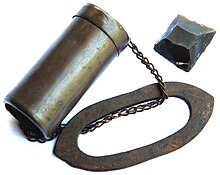Tinderbox


A tinderbox, or patch box, is a container made of wood or metal containing
Tinderboxes fell out of general usage when friction matches were invented.
History and use
Throughout prehistoric Europe
With the development of iron ore smelting in the Iron Age, the firesteel eventually replaced pyrites.[1] This was simply a piece of carbon steel (it is difficult to obtain sparks with ordinary iron), which was usually wrought into a 'D' shape, or an oval ring, so that it could be conveniently looped around two or three fingers for striking. The flint was sometimes chipped to provide a suitably sharp edge to obtain a spark and if necessary other hard stones, such as quartzite, chert or chalcedony could be substituted.[2]
The
In use the flint was struck in a vigorous downward motion against the steel, sending a shower of sparks into the tinder which was arranged in the bottom of the box. The sparks (actually pieces of burning steel broken off by the harder flint) created very small embers as they fell onto the charcloth, the glow of which, with some gentle blowing, would be enough to ignite a sulfur tipped wooden splint. The splint could then be carried to a candle, often set in a holder on the top of the box, and finally the cloth would be extinguished with a damper to preserve it for further use.[4] With skill, a fire could be started in under a minute, but at other times it took longer and occasionally a tiny pinch of gunpowder was added to encourage the process.[5]

When away from home small pocket tinderboxes were often carried, sometimes set with a burning glass (a magnifying lens) in the lid to light the tinder directly from the sun's rays.[6] The poorer people working in the fields would obtain a light by simply striking a flint on the back of a knife onto a piece of touchpaper that they carried in their pockets.[5]
The tinder pistol, based on the flintlock mechanism, was a more expensive alternative to the tinderbox and was in use in middle and upper-class homes in the 18th century. In the early 19th century a more efficient tinderbox was invented with a rotating metal wheel to create the sparks[4] and there were other more experimental devices available, such as the fire piston and the instantaneous light box.[6]

In the 18th and early 19th century tinderboxes were in common use, but with the advent of John Walker's 'friction lights' in 1827, where a match could be struck by withdrawing it from a piece of folded
As metaphor
In conventional usage, the term "tinderbox" refers to something that is so dry that it could catch on fire with the slightest provocation, perhaps even spontaneously like a forest fire. It is also used to describe a potentially volatile or violent situation. For instance, a prison in which there is unrest and the potential for a riot could be said to be 'a tinderbox of violence'.[12]
See also
References
- ^ The Jesuit relations and allied ... - Jesuits. 2007-09-28. Retrieved 2011-11-07.
- ^ Mors Kochanski, Bushcraft: Outdoor Skills and Wilderness Survival (Edmonton: Lone Pine Publishing, 1987), p. 16
- ^ An encyclopćdia of domestic economy ... - Thomas Webster, Mrs. William Parkes. Retrieved 2011-11-07.
- ^ ISBN 0854589996
- ^ ISBN 9780854096565.
- ^ ISBN 9781851490219.
- ^ Once upon a time - Charles Knight. Retrieved 2011-11-07.
- ^ The Past in the present - Sir Arthur Mitchell. Retrieved 2011-11-07.
- ^ The Penny magazine of the Society ... - Society for the Diffusion of Useful Knowledge (Great Britain). Retrieved 2011-11-07.
- ^ Collections historical ... - Powys-land Club. 2007-08-11. Retrieved 2011-11-07.
- ^ Transactions of the Cumberland ... - Cumberland and Westmorland Antiquarian and Archaeological Society, James Simpson, Richard Saul Ferguson, William Gershom Collingwood. 2007-07-25. Retrieved 2011-11-07.
- ^ "Tinderbox - meaning". The free dictionary. Retrieved 29 October 2013.
